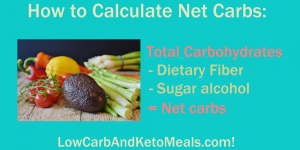How to Calculate Net Carbs

On any low-carb diet, you’ll be reducing your net carb gram intake. It’s important that you understand how to actually count net carbs! First, net carbs are simply the grams of total carbohydrates in a portion of food, minus its grams of fiber. Because fiber is a carbohydrate that your body cannot digest, it doesn’t raise your blood sugar levels, or trigger an insulin response.
Foods that are low in net carbs, which include nutrient-dense vegetables and fruits, are less likely to interfere with weight loss and do not have a significant impact on blood sugar. Here are a few zero- and low-carb foods to help you get started on understanding why they are often listed as acceptable foods in low-carb diets:
Examples of Zero Carbs:
- Beef
- Lamb
- Chicken
- Pork
- Bacon (Avoid bacon cured in sugar)
- Salmon
- Trout
Examples of Low Carb Vegetables:
- Broccoli – 6 grams per cup or 7 grams per 100 grams.
- Tomatoes – 7 grams in a large tomato, or 4 grams per 100 grams.
- Onions – 11 grams per cup or 9 grams per 100 grams.
- Brussels Sprouts – 6 grams per half cup, or 7 grams per 100 grams.
- Cauliflower – 5 grams per cup and 5 grams per 100 grams.
- Kale – 7 grams per cup or 10 grams per 100 grams.
- Cucumber – 2 grams per half cup or 4 grams per 100 grams.
Examples of Low Carb Fruits:
Be careful, as you can see fruits are higher in carbs than vegetables, due to their sugar content.
- Strawberries – 11 grams per cup or 8 grams per 100 grams.
- Apricots – 8 grams in 2 apricots, or 11 grams per 100 grams.
- Avocado – 13 grams per cup or 8.5 grams per 100 grams.
- Grapefruit – 13 grams in a half grapefruit, or 11 grams per 100 grams.
You can calculate, for yourself, the approximate number of net carb grams in a low-carb product. First look at the information on the food label:
Total Carbohydrates
– Dietary Fiber
– Sugar alcohol
= Net carbs
Often, the food label will break down carbohydrates into total carbohydrates, fiber, and sugars.
Total carbohydrates combine all of the carbs and include fiber, sugars, starches, sugar alcohols & glycerin. The label will show the amount found per serving & is measured in grams. They are found in starches, vegetables, fruits, sweets & milk.
Dietary fiber is the amount of indigestible or partially digestible bulk from plant foods like fruits, vegetables, whole grains, oats, nuts & seeds. It’s measured in grams.
Sugar alcohols are found most often in foods labeled “sugar-free,” including candy, cookies, chewing gums & soda. But have recently become popular in packaged health foods. Sugar alcohol gets its name from its molecular structure, which is a hybrid between a sugar molecule & an alcohol molecule. Biochemically speaking, sugar alcohols are structurally similar to sugar, but are either poorly digested or poorly metabolized.
Sugar alcohol has grown in popularity as a sugar replacement in foods because they contain fewer calories, have a minimal impact on insulin levels & are safe for those with diabetes.
Here’s a list of some popular sugar alcohols so you can identify them when you look at a nutrition label:
- Erythritol
- Maltitol
- Hydrogenated starch hydrolysates
- Isomalt
- Lactitol
- Mannitol
- Sorbitol
- Xylitol
It can be confusing, at first, when trying to calculate net carbs on your own. But now that you have the basic information you can practice it at home first. Soon you will be confident in your ability to count net carbs during your next trip to the grocery store!
